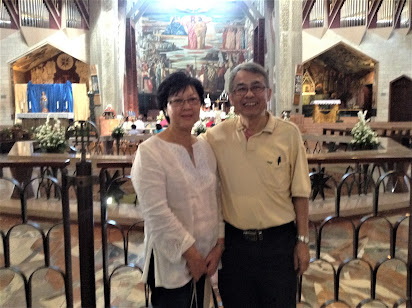In the eyes of the Catholics, Mary is probably the only human perceived as someone more than human and a little below supernatural or divine. She was after all the mother of Jesus.
There are countless of churches, schools, institutions and organizations in many countries across the world named after St. Mary. My wife was once the school principal of a secondary school called SM St. Mary Papar. A good friend of mine who now lives in Vancouver was once a student of one of the oldest secondary schools in Sabah, SM St. Mary Sandakan originally built in 1883. Therefore, it would be unthinkable not to have a church named after St. Mary in Israel.
We visited the Church of Annunciation in the old city of Nazareth which is one of the churches dedicated to Mary. The Church with magnificent design and architecture was built over a site believed by tradition to be the house of Mary. The Church was completed in 1969. The name "Annunciation" suggests that this was where angel Gabriel appeared to Mary and announced that she would conceive and bear the Son of God, Jesus.
At the ground level of the Church of Annunciation, grotto of Byzantine time is believed to be where Mary grew up.
The main church hall at the level above the grotto.
The uniqueness of this church is that there are many paintings and portraits of Mary in various nationalities.
Mary in Chinese costume and in Japanese costume.
A statute of Mary is prominently placed at the front of the Church of Annunciation. Similarly, a statute of Joseph, the husband of Mary is also erected in the courtyard of the Church of St. Joseph which is at one end of the church. The Church of St. Joseph built in 1914 is built over ruins of a 17th century AD crusader church.
A signboard in the church compound provides a good visual understanding of the Church of St. Joseph in relation to the Church of Annunciation. The Church of St. Joseph at the far end is significantly smaller compared to the Church of Annunciation at the near end.
Underneath the Church of St. Joseph is a series of rock-cut cavities and caves. The left photo is said to be a Byzantine era baptismal pool. The staircase in the right photo leads to a cave said to have been used by Joseph.
 |
| Leaving The Church of St. Joseph after the tour. |





















No comments:
Post a Comment